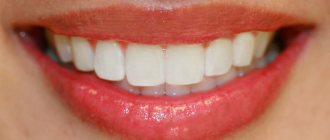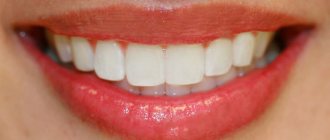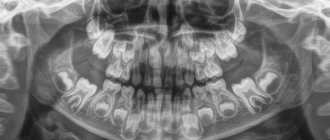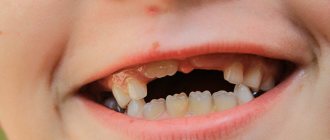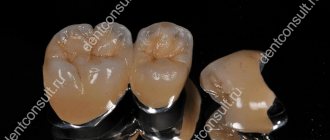Author of the article:
Soldatova Lyudmila Nikolaevna
Candidate of Medical Sciences, Professor of the Department of Clinical Dentistry of the St. Petersburg Medical and Social Institute, Chief Physician of the Alfa-Dent Dental Clinic, St. Petersburg
Cigarette plaque on teeth is an extremely unpleasant consequence of active smoking. It gradually accumulates on the enamel, causing its color to change.
When you abuse tobacco, your smile takes on a pronounced yellow or even dark brown tint, and unsightly stains appear on your teeth that cannot be removed with a brush.
The change in enamel color is a consequence of exposure to substances that are part of smoke, such as nicotine, phenolic and ammonia compounds, and tar. All of them firmly settle on the porous surface of the teeth, penetrating deeper and deeper over time, which leads to the fact that the yellowness becomes more and more pronounced.
The worse a smoker cares about oral health, the faster plaque forms, which ultimately leads not only to aesthetic problems, but also to deterioration in the quality of enamel.
If measures are not taken in a timely manner, the yellow plaque turns into gray-brown. This leads to inflammation of the gums and impaired blood circulation in them. Bleeding, periodontal disease, caries and tartar may occur. Further, the smoker may experience tooth loss, so it is worth paying attention and addressing the problem in a timely manner.
How cigarettes affect teeth
The main symptoms of oral disease that appear in smokers can be identified:
- gums become pale pink;
- periodontal tissues are not inflamed;
- the cervical surfaces of the teeth are covered with a dark brown coating;
- Possible bad breath.
Types of cigarette plaque
Plaque caused by smoking varies in color:
- White plaque forms throughout the day or at night. This is a soft plaque, the appearance of which is also promoted by eating food. It is not dangerous to health and can be easily eliminated with thorough brushing of your teeth.
- Green plaque is a consequence of deformation of the pellicle or exposure to a chromogenic fungus.
- Yellow and brown plaque is evidence of addiction to cigarettes, strong coffee or tea. It is formed due to exposure to pigments contained in smoke or products. Only dentists can completely remove stains or remove plaque from cigarettes on teeth. Professional cleaning and bleaching will be required.
- Black plaque. Teeth turn black from cigarettes if the development of processes that lead to yellow and gray plaque has not been stopped.
The effect of smoking on teeth color
Important! Cigarette smoke contains a huge list of substances and elements, including nicotine and various tars. With regular smoking, microparticles settle on the teeth and a specific yellowish plaque forms.
At the first stage, the problem is purely aesthetic in nature, but if it is not addressed, plaque leads to the formation of tartar, and also causes inflammation of the gums and contributes to the development of caries. The plaque caused by smoking initially has a yellow tint, but over time becomes darker to grayish-brown and black.
Gum inflammation caused by this harmful habit can become serious, accompanied by bleeding, gingivitis, periodontal disease and chronic bleeding gums. Smokers are also at risk of developing tooth decay. Almost all lovers of this habit have teeth in their mouths that require treatment. Their caries develops quickly, endlessly transmitted from tooth to tooth.
In addition, there are statistics according to which four out of ten smokers completely lose their teeth by age 65. Among non-smokers this figure is two times lower.
How to remove plaque on teeth from cigarettes at home
Home remedies won't completely get rid of cigarette residue, but they can help reduce its impact.
Regular teeth cleaning
Every smoker should understand that their teeth require more careful care. Brush your teeth at least twice a day, and preferably after every major meal. Give this process at least five minutes. There should be about 20 movements per tooth. Clean the outer side first, then move on to the chewing surface and the inner edge of the side teeth. Finally, clean your tongue and rinse your mouth. For hygiene, it is better to use specialized pastes and rinses; they will make the procedure more effective.
Home whitening with folk remedies
As bleaching agents, you can use soda, activated carbon and lemon, as well as hydrogen peroxide (Attention: peroxide should never be swallowed!). Simply apply the substance to the surface of the tooth. It is important to remember that such procedures can be performed no more than twice a week and it is necessary to take long breaks. Otherwise, you will damage the enamel, which will only lead to bigger problems. This type of whitening will not help completely remove stains from cigarettes, but it will make the color of your smile a couple of shades lighter.
Whitening with special means
There are many special products available for home removal of yellow stains from tooth enamel. These can be whitening strips or a professional gel, which is applied with a brush and requires the use of a protective mouthguard. Before you start using these products, you should consult your dentist.
Getting rid of smoker's plaque under the supervision of a doctor
Getting rid of plaque in dentistry guarantees effective whitening of tooth enamel and, which attracts most smokers, does not require any effort from the patient. All you need to do is come to the procedure and endure the not always pleasant manipulations and, of course, pay for it.
Do you want to know how to whiten your teeth after smoking under medical supervision? This can be done using several methods:
- Ultrasonic cleaning is one of the most effective and safest ways to get rid of plaque. Ultrasound penetrates deep into limescale deposits and destroys them without damaging the enamel. After cleaning, the remaining plaque is removed from the enamel surface and a special polishing is carried out, which helps protect the teeth from plaque formation.
- Professional whitening – helps change the color of the enamel by saturating it with ions or coating the enamel with a special substance.
- Artificial structures - sometimes neither home remedies nor special whitening can restore the original whiteness of teeth. In such situations, the use of veneers or other artificial structures can help.
How to remove cigarette plaque on teeth: clinical methods
There are several effective ways to completely remove plaque formed as a result of smoking.
The first option is professional cleaning. It can be carried out using an AirFlow device, which supplies a solution with crushed abrasives under pressure. You can also remove stones and plaque using ultrasound. In addition, plaque is removed manually using special instruments - scalers and curettes.
The second option is chemical bleaching. It is carried out after cleaning and is a purely cosmetic procedure, since it does not provide any benefits to dental health, but after a few sessions you can get a radiant white smile. Chemical whitening involves applying specialized gels based on hydrogen peroxide. The gel is applied for half an hour or more, in addition, its action can be activated by a laser or light from a halogen lamp (photobleaching).
After you have cleaned your teeth of plaque, you need to take good care of them. Ideally, quit smoking altogether or at least reduce the number of cigarettes. Remember to brush your teeth thoroughly and regularly, eat less coloring products, and use specialized toothpastes.
Effect of nicotine
Each cigarette or cigar smoked is a large amount of nicotine, carbon monoxide, methane, tarry substances and other dangerous products entering the oral cavity. In addition, hot smoke negatively affects the condition of the enamel; it destroys the beneficial bacteria present in the mouth and can cause the development of inflammatory processes.
But this is not the worst thing. Nicotine causes severe vasoconstriction in the soft tissues of the oral cavity. This leads to impaired blood circulation in them, which can cause atrophy of the mucous membrane. As a result, after some time, the roots of the teeth will be exposed, they will become more sensitive, they will begin to bleed at the slightest irritation or mechanical damage, and severe pain will appear.
Smokers may develop pathological processes such as gingivitis or periodontal disease. These diseases are very dangerous, because they affect the condition of the tissues surrounding the tooth root. As a result, this can lead to severe decay and even the need to remove the diseased tooth. At first, smokers' gums may bleed heavily; this is one of the first signs of developing diseases.
Clinical trials
Clinical studies have proven that regular use of professional toothpaste ASEPTA COFFEE AND TOBACCO for a month improved the hydration of the mucous membrane by 3.3 times, the remineralizing efficiency increased by 3.9 times, at the same time, the cleansing effect has increasing dynamics and reaches 60 .5% at 4 weeks of use.
Sources:
- Report on determining/confirming the preventive properties of toothpaste “ASEPTA PLUS” COFFEE and TOBACCO Author: doctor-researcher A.A. Leontyev, head Department of Preventive Dentistry, Doctor of Medical Sciences, Professor S.B. Ulitovsky. First St. Petersburg State Medical University named after. acad. I.P. Pavlova, Department of Preventive Dentistry
- Report on determining/confirming the preventive properties of toothpaste “ASEPTA PLUS” GENTLE WHITENING” Author: doctor-researcher A.A. Leontyev, head Department of Preventive Dentistry, Doctor of Medical Sciences, Professor S.B. Ulitovsky First St. Petersburg State Medical University named after. acad. I.P. Pavlova, Department of Preventive Dentistry
- Clinical and laboratory assessment of the influence of domestic therapeutic and prophylactic toothpaste based on plant extracts on the condition of the oral cavity in patients with simple marginal gingivitis. Doctor of Medical Sciences, Professor Elovikova T.M.1, Candidate of Chemical Sciences, Associate Professor Ermishina E.Yu. 2, Doctor of Technical Sciences Associate Professor Belokonova N.A. 2 Department of Therapeutic Dentistry USMU1, Department of General Chemistry USMU2
- Report on the determination/confirmation of the preventive properties of personal oral hygiene products “ASEPTA PLUS” Remineralization doctor-researcher A.A. Leontyev, head Department of Preventive Dentistry, Doctor of Medical Sciences, Professor S.B. Ulitovsky First St. Petersburg State Medical University named after. acad. I.P. Pavlova, Department of Preventive Dentistry
- Clinical studies of antisensitive toothpaste “Asepta Sensitive” (A.A. Leontyev, O.V. Kalinina, S.B. Ulitovsky) A.A. LEONTIEV, dentist O.V. KALININA, dentist S.B. ULITOVSKY, Doctor of Medical Sciences, Prof. Department of Therapeutic Dentistry, St. Petersburg State Medical University named after. acad. I.P. Pavlova
- The role of anti-inflammatory rinse in the treatment of periodontal diseases (L.Yu. Orekhova, A.A. Leontyev, S.B. Ulitovsky) L.Yu. OREKHOVA, Doctor of Medical Sciences, Prof., Head of Department; A.A. LEONTIEV, dentist; S.B. ULITOVSKY, Doctor of Medical Sciences, Prof. Department of Therapeutic Dentistry of St. Petersburg State Medical University named after. acad. I. P. Pavlova
Prevention
It is always easier to prevent pathology than to treat it. In order to avoid the appearance of plaque, it is best to get rid of the bad habit of smoking. If this cannot be done, then you need to at least minimize the number of cigarettes you smoke. Additional preventive measures are:
- thorough dental hygiene at least twice a day using a toothbrush, floss and mouthwash;
- timely replacement of the toothbrush;
- rinsing the mouth after every meal or smoking;
- control over the amount of coffee and strong tea consumed;
- alternating different types of toothpaste;
- regular oral hygiene at the dentist.
It is better to solve the problem at the stage while the above simple recommendations are effective. If you do not give up the bad habit, as well as neglect preventive measures, then plaque after smoking can lead to serious oral diseases.
Category Hygiene Published by Mister stomatolog
Lips
If you have been smoking for many years, then you are almost certainly familiar with the problem of dry lips. The thing is that smokers produce less saliva (the body refuses to perceive a cigarette as something edible), so a person experiences a feeling of dryness and involuntarily licks his lips. At the same time, they lose their protective water-fat film and instantly become weathered in the air. As a result, inflammation of the red border of the lips develops - cheilitis.
Your actions. Use a special moisturizing lipstick with medicinal ingredients, such as cocoa butter, almond oil, and chamomile extract. You can also lubricate your skin with a softening baby cream with vitamins A and E before going to bed.
It is also worth paying attention to toothpaste - sometimes it worsens the condition of the lips. Pastes containing fluoride are especially aggressive on the skin and can cause persistent irritation. Give them up for a while and choose pastes with herbal anti-inflammatory ingredients.
General tips to help maintain white teeth
For those who cannot imagine their life without a cigarette, but want to maintain the normal condition and appearance of their teeth, there are general rules:
- To clean your teeth, it is advisable to use toothbrushes with hard and medium bristles. Such hygiene items will help to better remove plaque and maintain healthy enamel.
- Nutrition is of great importance. Vegetables and fruits will help clean your teeth while eating: carrots, apples, spinach, corn, strawberries.
Such regular cleansing from nicotine will not harm even those who have contraindications due to oral diseases:
- special sensitivity of enamel, its heterogeneity and wear;
- any gum disease.
How does tobacco smoke affect the condition of teeth and gums?
At the moment of inhalation, the temperature of tobacco smoke is quite high. As a result, the mucous membrane of the oral cavity is burned and dried out. The amount of saliva, which has antibacterial properties, decreases. As a result, the possibility of pulpitis, periodontitis, gingivitis, and caries increases.
In addition, with each puff, a certain amount of resin enters the oral cavity. It is highly sticky and adheres firmly to the teeth. As a result, their color noticeably deteriorates. But this is just the tip of the iceberg. Pathogenic microorganisms actively multiply under the resin layer. They penetrate into small cracks on the surface of the enamel, destroying it. As a result, caries develops, and if a person does not treat it, pulpitis and other complications may appear in the future.



